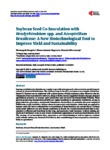Use este identificador para citar ou linkar para este item:
http://www.alice.cnptia.embrapa.br/alice/handle/doc/1012889Registro completo de metadados
| Campo DC | Valor | Idioma |
|---|---|---|
| dc.contributor.author | HUNGRIA, M. | pt_BR |
| dc.contributor.author | NOGUEIRA, M. A. | pt_BR |
| dc.contributor.author | ARAUJO, R. S. | pt_BR |
| dc.date.accessioned | 2015-04-07T11:11:11Z | pt_BR |
| dc.date.available | 2015-04-07T11:11:11Z | pt_BR |
| dc.date.created | 2015-04-07 | pt_BR |
| dc.date.issued | 2015 | pt_BR |
| dc.identifier.citation | American Journal of Plant Sciences, [S. l.], v. 6, p. 811-817, Apr. 2015. | pt_BR |
| dc.identifier.issn | 2158-2750 | pt_BR |
| dc.identifier.uri | http://www.alice.cnptia.embrapa.br/alice/handle/doc/1012889 | pt_BR |
| dc.description | Legume nodulation by rhizobia can supply crops with nitrogen and reduce environmental impacts caused by chemical fertilization. The soybean crop in Brazil is an impressive example of how biological N2 fixation can be employed with a plant species of high economic value. However, the development of more productive cultivars, along with the increasing global climatic changes demand agricultural practices to become more productive and yet more environmentally friendly. Plant growth-promoting rhizobacteria (PGPR) are highly beneficial to agriculture worldwide, acting in plant nutrition, protection, and growth stimulation. Azospirillum is, certainly, the most employed PGPR in the world, but little is known about its interaction with rhizobia, when both are applied to legume seeds. We have evaluated the co-inoculation of bradyrhizobia and azospirilla on soybean seeds under different soil and climate conditions in Brazil. Our results demonstrated that co-inoculation is efficient and beneficial to the crop, and promotes yield increases without adding any chemical N fertilizers even in soils where established populations of soybean bradyrhizobia exist. The strategy of co-inoculation thus represents a new biotechnological tool to improve soybean yield without adding any chemical N fertilizers, thus contributing to current practices of sustainability in agriculture. | pt_BR |
| dc.language.iso | eng | eng |
| dc.rights | openAccess | eng |
| dc.title | Soybean seed co-inoculation with Bradyrhizobium spp. and Azospirillum brasilense: a new biotechnological tool to improve yield and sustainability. | pt_BR |
| dc.type | Artigo de periódico | pt_BR |
| dc.date.updated | 2017-05-11T11:11:11Z | pt_BR |
| dc.subject.thesagro | Soja | pt_BR |
| dc.subject.thesagro | Inoculante | pt_BR |
| dc.subject.nalthesaurus | Soybeans | pt_BR |
| riaa.ainfo.id | 1012889 | pt_BR |
| riaa.ainfo.lastupdate | 2017-05-11 | pt_BR |
| dc.identifier.doi | http://dx.doi.org/10.4236/ajps.2015.66087 | pt_BR |
| dc.contributor.institution | MARIANGELA HUNGRIA DA CUNHA, CNPSO; MARCO ANTONIO NOGUEIRA, CNPSO; RICARDO SILVA ARAUJO, Total Biotecnologia. | pt_BR |
| Aparece nas coleções: | Artigo em periódico indexado (CNPSO)  | |
Arquivos associados a este item:
| Arquivo | Descrição | Tamanho | Formato | |
|---|---|---|---|---|
| 2015HungriaetalAJPS.pdf | 316,94 kB | Adobe PDF |  Visualizar/Abrir |









